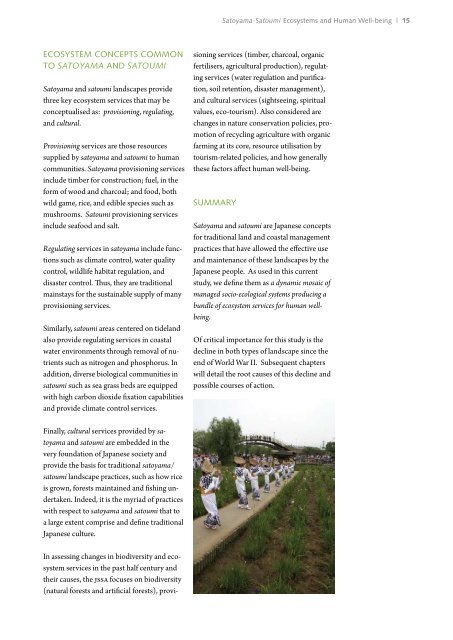Satoyama-Satoumi Ecosystems and Human Well-Being - UNU-IAS ...
Satoyama-Satoumi Ecosystems and Human Well-Being - UNU-IAS ...
Satoyama-Satoumi Ecosystems and Human Well-Being - UNU-IAS ...
Create successful ePaper yourself
Turn your PDF publications into a flip-book with our unique Google optimized e-Paper software.
<strong>Satoyama</strong>-<strong>Satoumi</strong> <strong>Ecosystems</strong> <strong>and</strong> <strong>Human</strong> <strong>Well</strong>-being | 15<br />
Ecosystem concepts common<br />
to satoyama <strong>and</strong> satoumi<br />
<strong>Satoyama</strong> <strong>and</strong> satoumi l<strong>and</strong>scapes provide<br />
three key ecosystem services that may be<br />
conceptualised as: provisioning, regulating,<br />
<strong>and</strong> cultural.<br />
Provisioning services are those resources<br />
supplied by satoyama <strong>and</strong> satoumi to human<br />
communities. <strong>Satoyama</strong> provisioning services<br />
include timber for construction; fuel, in the<br />
form of wood <strong>and</strong> charcoal; <strong>and</strong> food, both<br />
wild game, rice, <strong>and</strong> edible species such as<br />
mushrooms. <strong>Satoumi</strong> provisioning services<br />
include seafood <strong>and</strong> salt.<br />
Regulating services in satoyama include functions<br />
such as climate control, water quality<br />
control, wildlife habitat regulation, <strong>and</strong><br />
disaster control. Thus, they are traditional<br />
mainstays for the sustainable supply of many<br />
provisioning services.<br />
Similarly, satoumi areas centered on tidel<strong>and</strong><br />
also provide regulating services in coastal<br />
water environments through removal of nutrients<br />
such as nitrogen <strong>and</strong> phosphorus. In<br />
addition, diverse biological communities in<br />
satoumi such as sea grass beds are equipped<br />
with high carbon dioxide fixation capabilities<br />
<strong>and</strong> provide climate control services.<br />
sioning services (timber, charcoal, organic<br />
fertilisers, agricultural production), regulating<br />
services (water regulation <strong>and</strong> purification,<br />
soil retention, disaster management),<br />
<strong>and</strong> cultural services (sightseeing, spiritual<br />
values, eco-tourism). Also considered are<br />
changes in nature conservation policies, promotion<br />
of recycling agriculture with organic<br />
farming at its core, resource utilisation by<br />
tourism-related policies, <strong>and</strong> how generally<br />
these factors affect human well-being.<br />
Summary<br />
<strong>Satoyama</strong> <strong>and</strong> satoumi are Japanese concepts<br />
for traditional l<strong>and</strong> <strong>and</strong> coastal management<br />
practices that have allowed the effective use<br />
<strong>and</strong> maintenance of these l<strong>and</strong>scapes by the<br />
Japanese people. As used in this current<br />
study, we define them as a dynamic mosaic of<br />
managed socio-ecological systems producing a<br />
bundle of ecosystem services for human wellbeing.<br />
Of critical importance for this study is the<br />
decline in both types of l<strong>and</strong>scape since the<br />
end of World War II. Subsequent chapters<br />
will detail the root causes of this decline <strong>and</strong><br />
possible courses of action.<br />
Finally, cultural services provided by satoyama<br />
<strong>and</strong> satoumi are embedded in the<br />
very foundation of Japanese society <strong>and</strong><br />
provide the basis for traditional satoyama/<br />
satoumi l<strong>and</strong>scape practices, such as how rice<br />
is grown, forests maintained <strong>and</strong> fishing undertaken.<br />
Indeed, it is the myriad of practices<br />
with respect to satoyama <strong>and</strong> satoumi that to<br />
a large extent comprise <strong>and</strong> define traditional<br />
Japanese culture.<br />
In assessing changes in biodiversity <strong>and</strong> ecosystem<br />
services in the past half century <strong>and</strong><br />
their causes, the JSSA focuses on biodiversity<br />
(natural forests <strong>and</strong> artificial forests), provi-
















